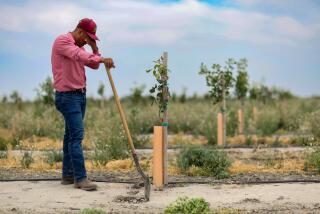Malibu vintners fight to stop extension of ban on new vineyards
- Share via
Malibu vintners and grape growers are trying to stop the six-month extension of a temporary ban on new vineyards, or extensions of existing ones, in the north area of the Santa Monica Mountains. Concerns about the drought and vineyards’ potential water use are behind the ban.
The ban was imposed by the Los Angeles County supervisors on June 16. The decision whether to extend the ban or not takes place on Tuesday, July 28.
The ban was put in place after there was a perceived rush on applications for vineyard permits in the unincorporated north area of the Santa Monica Mountains, which includes unincorporated Malibu, Agoura, parts of Calabasas and Topanga.
Supervisor Sheila Kuehl weighs in: “As I indicated when I first put in the motion for a ban — only in the north area of Santa Monica Mountains — the number of applications for new vineyards worried me in the aggregate because of the overall amount of additional water that could be drawn down, as well as there being no information about what chemicals or pesticides might be added to runoff. These were not just half an acre or small backyard vintners, but applicants for larger vineyards. People just drill wells. They draw water.”
She cites a study that found that in Central California, the water table had been lowered significantly. “And in the mountains, we don’t have a way to measure the impact of vineyards drawing off water upstream.”
Dan Fredman, owner of a small backyard vineyard and a spokesperson for the Malibu Coast Vintners & Grape Growers Alliance, says, “when we saw the proposed measure, we were down at the planning commission offices as quickly as we could, to provide them with correct information on grapevines and viticulture as it’s practiced in Malibu.”
Vine growers feel that the moratorium is unnecessary because they’ve already begun working with Anita Gutierrez in the Department of Regional Planning to address the commission’s concerns about vineyards in the area.
One thing that drew their interest was the fact that 51 applications were made for new vineyards in a ten-month period, whereas the previous year generated only three.
Nicole Englund, incoming Supervisor Sheil Kuehl’s planning and transportation deputy, says, “fifteen cases have been approved since May of 2014 and those encompassed approximately 270 acres. And then we have 28 cases that are still pending and those encompass 297 acres.” Gutierrez confirmed those figures, saying roughly 300 acres of potential vineyards are in limbo.
Some landowners applied for vineyards for their entire property and may have only planted on a small portion of their land, but the supervisor’s office has no way of knowing that.
When the alliance investigated, they found all those applications had been made because at a meeting with planning commission representatives a year ago, homeowners in the Triunfo/Lobo area were advised to get in their applications if they were even thinking about planting a vineyard in the future. They took the advice to heart, fearing they’d be shut out in the future unless they had a permit for a vineyard grandfathered in.
“The real hardship is directed at the landowners who have already submitted applications for vineyard permits and are legally entitled to plant crops on their agriculturally zoned land,” says Montage Vineyards’ John Gooden, president of the Malibu Coast Vintners & Grape Growers Alliance.
“All these people were trying to do was comply with the law and they went ahead and hired land use consultants, had maps drawn, et cetera. This ordinance is discriminating against grapes. They’re not banning avocado orchards and they use seven times the amount of water that grapevines do.”
Malibu is not and never was poised to become the next Napa Valley. With the exception of vineyards in the Kanan/Mulholland area, plots are small. Most are farmed sustainably by the families themselves. Vines are drought-tolerant. In fact, the plants produce better fruit when they’re stressed.
Vineyards in Malibu are irrigated, if at all, by drip irrigation. That means there’s no runoff, and the water goes to the plant’s roots.
“The members of the alliance have become absolute misers in terms of our water use,” says Fredman. “We farm sustainably and with acute attention to the beauty of our natural surroundings.”
The Malibu Coast Vintners and Grape Growers Alliance also discovered that the figures cited by the supervisors were incorrect. Several properties applying for new permits had been assigned multiple permit numbers, and in many cases the entire acreage had been counted rather than just the portion under vines.
“In the big scheme of things, we’re talking about an insignificant amount of acreage. The north area encompasses 21,188 acres, and the acreage under consideration is not even 2% of that, so would not have an impact on the environment,” says Gooden.
“Vineyards should have a place in the land use plan. They’ve been in the Santa Monica Mountains for over 200 years. We’re just trying to continue a tradition of sustainable family farming.“
All this week members of the alliance have been meeting individually with supervisors and planning staffers to explain their position and predicament. The vote comes up again on Tuesday, when they’re trying to get as many of their own members — and any other interested wine lovers — to show support against extending the ban at the supervisors meeting at 9:30 a.m.
They’re also encouraging people to go to their website and sign a petition supporting vineyards in the Santa Monica Mountains.
Follow @sirenevirbila for more on food and wine.
More to Read
Eat your way across L.A.
Get our weekly Tasting Notes newsletter for reviews, news and more.
You may occasionally receive promotional content from the Los Angeles Times.










